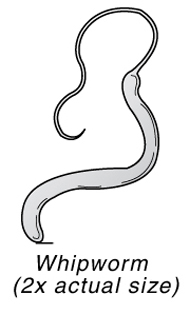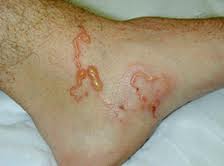Worms

 Why should you deworm your pet?
Why should you deworm your pet?
There is a high incidence of worms in dogs and cats. Some surveys indicate that in certain urban areas up to 50% of companion animals are infected with worms. These parasites are not only detrimental to the health of the animals, but many of them are contagious to people too.
What symptoms will be noticeable if your pet has worms?
Some animals don’t show any symptoms, while others can get very sick and can even die. General symptoms include listlessness, weight loss, poor hair coat, weakness, pale gums or a pot-belly. Digestive tract symptoms include a poor or increased appetite, vomiting, diarrhoea, black stool or fresh blood in stool. Behavioural symptoms include scooting, eating of grass, chewing of feet and coughing.
What type of worm infestation can your pet pick up?


Roundworms: Toxocara and Toxascaris
Roundworms have a complicated life cycle even though no intermediate host is required for them to mature. The immature worms can form cysts in your pet’s muscles before moving to the intestines. Practically this means that immature worms can migrate across the placenta or through the milk to infect foetuses as young as 11 days old. This process also has implications for humans because if we accidently eat worm eggs they can hatch and migrate from the stomach to encyst our lungs, liver or eyes causing a disease called Visceral or Ocular Larva Migrans. Intestinal infestations are easy to spot in puppies and kittens. They develop pot bellies and tend to get tummy upsets.


Hookworms: Ancylostoma
They attach to the intestinal walls and suck the host’s blood which means that one of the main symptoms of an infection is anaemia, which presents as pale gums and a weak pulse. They are also usually spread by ingesting the eggs however the immature worms can also enter via the skin. Unfortunately not only do they burrow into your pet’s skin but they can burrow into yours as well. They usually go via the feet and cause a disease called Cutaneous Larva Migrans.


Whipworms: Trichuris
These worms infect the colon and cause severe irritation to the lining of this organ. This results in watery, bloody diarrhoea and weight loss. They are of the most harmful worms found in dogs. They are not infective to people.


Tapeworms: Dipylidium and Echinococcus
An intermediate host is required for this worm’s lifecycle. Some tapeworm species use the common flea and others use mammals such as sheep or even humans. This intermediate phase in man causes cyst formation in the lungs or brain. In dogs digestive upsets and bowel blockages are the main symptoms of an infestation. Control measures involving regular deworming together with avoidance of feeding raw or under-cooked offal are obvious precautions.
Spira Cerca lupi: It is worm that is transmitted to dogs primarily by several species of dung beetles or by other small animals that have ingested infected beetles. After the larva penetrate the stomach they migrate to the middle of the chest cavity between the aorta and the oesophagus. Inflammatory tissue forms a distinct nodular granuloma around the adult worms that protrudes into the oespohagus itself. Cancerous transformation occurs in the granulomatous tissue of some infected dogs which develop a Spirocerca-associated sarcoma. You veterinarian will have to diagnose the disease and prescribe a cure. There are various dewormers that can be used to prevent and infection from occuring.
Ringworm: Dermatophyte
Ringworm is actually a fungal infection and not a worm at all. Typically it will produce a discrete irregular or circular patch of hair loss, accompanied by variable scaling, crusting, thickening and reddening of the skin. It is diagnosed by either culturing infected hairs or it could be one of the 60% of species that glows bright green under a UV light. Ringworm can improve on its own after a 3-5 month period or it can be treated topically or systemically. Systemic treatment is only available from your vet. Hairs infected with ringworm contain numerous microscopic fungal spores which can be shed into the environment. These are contagious to other animals and humans. Topical treatment or shampooing of affected skin and clipping of infected hairs may help to reduce environmental contamination. Daily vacuuming of rooms to which your pet has access is the best way to minimise environmental contamination. In addition, the use of a disinfectant is recommended in areas that can be readily disinfected. You should see an improvement after 2-3 weeks. Speak to your doctor if you or your children develop any similar round skin lesions or hair loss.
Heartworm
This disease is a major problem in parts of southern Europe and the United States. The worms are located mainly in the right ventricle of the heart and adjacent blood vessels. It is yet to be diagnosed in South Africa but with the easy of animal exportation and availability of the intermediate host in this country it may only be a matter of time before they cause a problem. The period of development to the adult stage is about six months after infection following a bite by a mosquito carrying the infective larvae (Microfilariae). The typical signs are fatigue on exercise, coughing and poor condition.
How can your pet pick up worms?
They can get infected in many different ways. Puppies and kittens can be born with parasites that they got from their mother while they were still in the womb or through their mother’s milk. They can pick up worms by sniffing or ingesting other animal’s faeces. Some worms have an intermediate host like a flea, dung beetle or cockroach which can be eaten. Some worms are found in raw meat. Others enter the body through the skin.
What is a zoonosis?
It is a disease that is transmissible from animal to human. Children are more prone to infection from worms because they walk with bare feet and more likely to put obscure objects in their mouths. Roundworm, hookworm and tape worm are all zoonoses.
How are they diagnosed?
Worms often go undetected because the symptoms vary and can be very mild. A faecal flotation test is performed on a single or pooled sample of faeces. The eggs are identified under the microscope. Pooled samples are sometimes used because adult worms are not continually laying eggs and so your vet may need to check a few days’ worth of stool.
How can I treat an infection?
If your animal has been diagnosed with an infection then generally 2 treatments are required at a 2-4 week interval and every 3-6 months thereafter as a preventative measure. A single dose is seldom sufficient to eradicate a worm infection. The majority of preparations available today kill only the adult worms and do not affect migrating or encysting larvae. It is therefore important that repeated treatments are carried out and it is for this reason that we suggest worming puppies every two weeks until at least eight weeks of age and then on a regular basis thereafter.
How can I prevent an infection?
Deworm your pet every 3-6 months. Go for the 3 month option if your pet spends a lot of time outdoors and in contact with other animals.
Deworm pregnant bitches and queens according to strict guidelines.
Deworm puppies from 2 weeks and kittens from 4 weeks of age and follow strict guidelines thereafter.
Keep your environment clean especially if you have children.
How do I know if my child has worms and how can I treat them?
Speak to your doctor if you suspect your child has worms or if he/she has been in close contact with dogs or cats.
